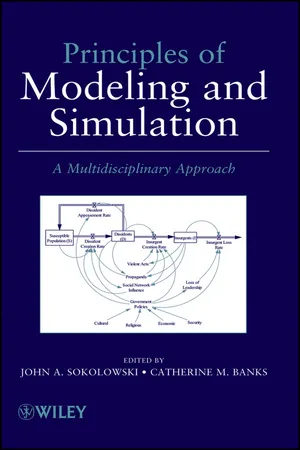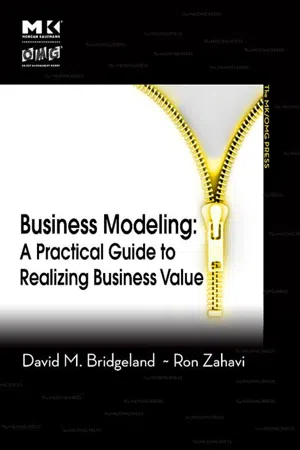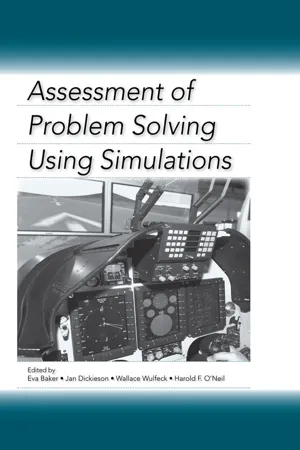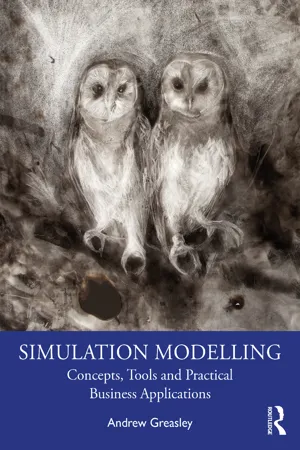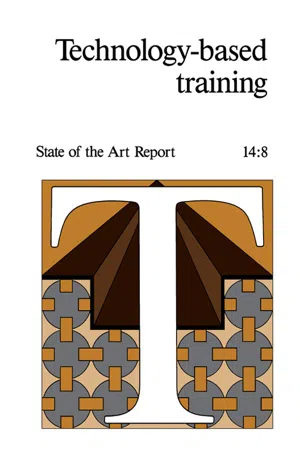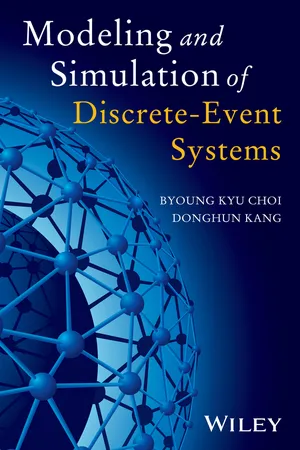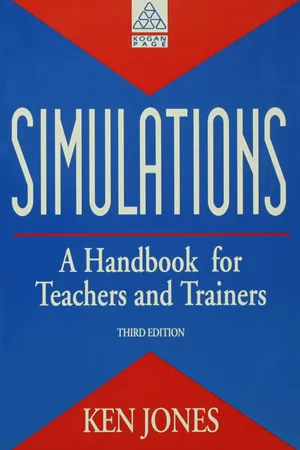Business
Simulation
Simulation refers to the imitation of a real-world process or system using a model to understand its behavior or make predictions. In a business context, simulation can be used to test different strategies, optimize processes, or forecast outcomes. By simulating various scenarios, businesses can make informed decisions and minimize risks.
Written by Perlego with AI-assistance
Related key terms
Related key terms
1 of 4
Related key terms
1 of 3
10 Key excerpts on "Simulation"
- eBook - ePub
Principles of Modeling and Simulation
A Multidisciplinary Approach
- John A. Sokolowski, Catherine M. Banks, John A. Sokolowski, Catherine M. Banks(Authors)
- 2011(Publication Date)
- Wiley(Publisher)
In this chapter, we concentrate on the technical meanings of Simulation. It is worth knowing that American sociologist Daniel Bell stressed the pivotal importance of technical aspects of Simulation in post-industrial (or information, or knowledge) societies. This view was presented to Simulationists in the 1970s: As Bell, who explains that in post-industrial societies the methodologies are abstract theories: models, Simulation, decision theory, and system analysis, states it: “The key political problems in a post-industrial society are essentially elements of science policy” [6, 7]. It is a very satisfactory state of affairs that, at the beginning of the 21st century, Simulation is accepted by the U.S. House as a Nationally Critical Technology [8]. It would be wise for many other countries to follow suit to benefit from the advantages of Simulation. In the sequel, both technical and nontechnical meanings are provided; however, the latter category is for the sake of completeness.Technical meaningsExperimentation aspect of Simulation: (Simulation is performed for decision support, understanding, and education.)1. Simulation is goal-directed experimentation with dynamic models. A dynamic model has time-varying characteristics and can be mathematical, symbolic, or physical.Experience aspect of Simulation: (Simulation is performed either to provide experience for entertainment or to enhance skills.) Hence, two additional definitions of Simulation follow:2. Simulation is use of a representation of a real system to provide experience for entertainment .3. Simulation is use of a representation of a real system to provide experience for training to develop and/or enhance three types of skill, i.e., motor skills, decision-making skills, or operational skills.” For the last three categories of skills, associated three types of Simulation are virtual, constructive, and live Simulations, respectively.4. Within the perspective of using a representation (a model) of an existing, desired, or a hypothetical system, to provide experience, Simulation also means something similar, an imitation, but not the real thing, e.g., simulated battleground and simulated forces.5. Hence, a combined and concise definition of Simulation is:Simulation is goal-directed experimentation with dynamic models or use of a representation of a real system to provide experience for entertainment or for training to develop and/or enhance three types of skill, i.e., motor skills, decision-making skills, or operational skills.Nontechnical meanings - eBook - ePub
- Pascal Cantot, Dominique Luzeaux, Pascal Cantot, Dominique Luzeaux(Authors)
- 2013(Publication Date)
- Wiley-ISTE(Publisher)
The second definition is interesting, as it introduces an essential element: time. The model under consideration is not fixed: it evolves over time, as in the case of our falling billiard ball model. It is this temporal aspect that gives life to a model in a Simulation, as Simulation is the implementation of a model in time. To simulate, therefore, is to make a model “live” in time. The action of Simulation can also refer to the complete process which, from a need for modeling, allows the desired results to be obtained. In general, this process can be split into three major steps, which we will cover in more detail later: – design and development of the model; – execution of the model; – analysis of the execution. Strictly speaking, the definition given above refers to the second step, which is misleading, as the most important part is the design of the model, on which the results and the interpretation of results depend. The last step is not always easy: when the results consist of several thousands of pages of figures which the computer “spits out”, it can take weeks of work to reach the core substance. Use of the full term “modeling and Simulation” is therefore helpful, as it emphasizes the importance of the preliminary modeling work. Note that Simulation also designates the computer software used to build and execute a model. Figure 1.7. General principle of Simulation Figure 1.7, based on [ZEI 76], resumes the general principle of Simulation: we take as point of departure a real system, with its environment and a usage scenario, and we construct an abstraction, the model, which is then made concrete by a Simulation application - eBook - ePub
Business Modeling
A Practical Guide to Realizing Business Value
- David M. Bridgeland, Ron Zahavi(Authors)
- 2008(Publication Date)
- Morgan Kaufmann(Publisher)
Howard Gardner describes seven techniques for changing people’s minds: reason, research, resonance, redescriptions, rewards, real-world events, and resistances [Gardner 2004]. When well-designed, a Simulation can play to three of these techniques. First, when someone plays a Simulation, she becomes engaged. The Simulation feels real to her, as though she is really (for example) a mayor of a city. The (simulated) real-world events change her mind. Second, a Simulation provides an environment for someone to do (simulated) research by letting her try out experiments and seeing what happens. These experiments are in some ways better than real-world research because they can be performed quickly and without risk. Many alternatives can be tried out that would be expensive or impossible to try in the real world. Finally, a Simulation is in its very essence a redescription, a different way to tell a story that can supplement a traditional pitch.As personal experience, we have used business Simulations in the sales pursuit of many large system integration projects. We have sold projects worth a total of several billion US dollars using Simulation. Our personal experience is that Simulations are strikingly effective in demonstrating a deep understanding of a customer’s problems, and convincing them that a proposed solution will solve those problems.Simulations are also good for analysis . Chapter 10 describes several analysis techniques—ways of analyzing a model to reach conclusions about either the model or the business situation being modeled. Simulation can be used as an additional analysis method, a dynamic analysis method to complement the static methods of Chapter 10 .Why do we need another analysis method? For larger models, there are many questions that are too difficult to answer via static analysis. For example, with a small and simple business process model, it might be possible to analyze the cost of the end-to-end process using static analysis without Simulation. But most processes are not small and simple. Most have many activities, and the more activities a process has, the more difficult it is to analyze statically. Most processes are complex, with uncertainty, intermittent resource constraints, and cyclic behavior. Complex processes are very difficult to analyze statically. Simulation is required for all but the smallest and simplest business processes.Motivation models have the same characteristics. Small and simple motivation models can be analyzed statically to determine how the goals, strategies, and influences will lead to results. But most motivation models are neither small nor simple. They have many interacting elements, and they have feedback, time delays, and uncertainty. For these larger and more complex motivation models, Simulation is the only effective method of understanding what will happen. - eBook - ePub
- Leonhard E. Bernold, S. M. AbouRizk(Authors)
- 2010(Publication Date)
- Wiley(Publisher)
Chapter 4Introduction to Simulation and Its Use in Modeling Production SystemsSimulation is “the mathematical representation of the interaction of real-world objects.”—Free Online Encyclopedia (http://encyclopedia2.thefreedictionary.com/Simulation )Simulation is the process of building digital models of real-world systems and experimenting with them on a computer. —Paul A. FishwickProduction systems such as those discussed in this book lend themselves to Simulation modeling. If you think of a production system, you normally would visualize the item being produced and the resources (people, equipment, etc.) producing it. The production process can, therefore, be analyzed by tracing or modeling how the resources are engaged during the production process. We can generalize and simplify this to say that we can model and analyze a production process by trying to describe which resources are involved in manufacturing a product, and the activities they follow in the process.Simulation is a great medium to help us describe and analyze production systems. Within the vast realm of Simulation there are many tools, such as 3D visualization, which lets us represent a product in CAD and navigate through it. And four-dimensional modeling lets us visualize how the product is being built in three dimensions, by following each step in assembling the 3D components. And so on.In this chapter, we will focus on one branch of Simulation called process interaction discrete event Simulation. This branch enables us to model a production system, with its resources, activities and overall processing logic, in order to analyze it.Worked-Out Problem 4.1: Analyzing Cycle TimesThe most simplistic form of analyzing production systems is to model and analyze their cycle times. If we define a production in the form then we can measure what has been produced and the time it takes to produce it, to calculate production. Normal measures of production in construction include units/hour (e.g. m3 - eBook - ePub
- Eva Baker, Jan Dickieson, Wallace Wulfeck, Harold F. O'Neil(Authors)
- 2017(Publication Date)
- Routledge(Publisher)
Simulations and games have been used in the context of computer-based learning since the 1960s. They have depicted a specific phenomenon within a model that is executable on a computer. This chapter refers to phenomena in economic contexts, particularly enterprises competing with each other in a simulated market. The model of the enterprises and the market represents the complexity and dynamics of business structures and concepts the participants have to cope with within the Simulation. The use of business Simulations can target different objectives (Breuer, Molkenthin, & Tennyson, 2006; Lainema & Nurmi, 2006):• Acquisition of structural knowledge• Development of domain-specific problem-solving competencies• Elaboration of holistic views toward complex phenomena• Fostering meta-cognitive competencies (self-regulation and self-monitoring; O’Neil, 2002)• Support for the ability of role-taking• Buildup of the ability for coping with dynamicsThe traditional concept of using business Simulations can be divided into three phases: briefing, Simulation or gaming, and debriefing (Capaul, 2001). The three phases are usually moderated and supported by one or more teachers (= moderator). Within the first phase (briefing), the participants receive an introduction to the structure and the rules within the model. This is necessary to activate prior knowledge, which can be referred to by the participants. Within the briefing, the participants are confronted with a problem they ought to solve within the follow-up Simulation, for example, to gain a higher market share within a growing market. Because learning with business Simulation refers to the paradigm of problem-based learning, the selection of an appropriate problem is an important aspect (Tennyson & Breuer, 2002). The participants should elaborate their mental model about the concepts represented within the Simulation model by solving a given problem; that is, the appropriate knowledge to solve the problem is not available at this point in time. Otherwise, from the perspective of the participants, the presented “problem” would be a task only. In this situation, learning takes place in the sense of automating existing knowledge. - eBook - ePub
Simulation Modelling
Concepts, Tools and Practical Business Applications
- Andrew Greasley(Author)
- 2022(Publication Date)
- Routledge(Publisher)
A further finding from the case study was the lack of involvement from the shop floor in the development of the Simulation model and the subsequent decision. The company was going through a period of organisational change, not only in the way they manufactured the product but also in their approach towards human resources. They were attempting to move away from adversarial labour relations with a multi-union site to a single union agreement and a reorganisation of the management hierarchy to a much flatter system with managers reporting directly to the managing director. Within this context of change, the company could have used the Simulation project to develop involvement from the shop floor in a number of areas. When requiring information on the current configuration of machinery, the industrial engineers and management were not inclined to ask the shop floor. If they were unsure, a guess was made between the group rather than approach those on the shop floor. Although this probably reflects the traditional nature of the organisation, it was an ideal opportunity in the current climate of change to break the traditional mould and move to shop floor input on the project. Simulation can be a strong facilitator for communicating ideas up and down an organisation. Engineers, for example, could have used the Simulation to communicate the reasons for taking certain decisions to shop-floor personnel who might suggest improvements. Thus, the use of Simulation as a tool for employee involvement in the improvement process could be a vital part of the overall change strategy.Extract from Greasley (2004)Determining the Level of Usage of the Simulation Model
The objective of the Simulation method is to aid decision-making by providing a forum for problem definition and providing information on which decisions can be made. Thus, a Simulation project does not necessarily require a completed computer model to be a success. However, for many complex and interacting systems (most business systems), the model will be able to provide useful information which will aid the decision-making process. The focus of the Simulation project implementation will be dependent on the intended usage of the model as a decision-making tool (table 11.1 - eBook - ePub
Technology–Based Training
State of the Art Report 14:8
- M Labinger, P J Finch(Authors)
- 2014(Publication Date)
- Pergamon(Publisher)
Often, the experiences that we would like to arrange are too difficult, too dangerous, too time consuming, too expensive or just impossible. Experiences are not pure. The particular skill or piece of information that we want the student to acquire is mixed up with a variety of other skills and information, some more relevant than others, which may confuse him, particularly in the early stages. Even if they do not confuse, they may add considerably to the time needed to gain the experience and this may put more pressure on a timetable that is already crowded. On the other hand, the added complexity may add fidelity to the experience and so help the student to perceive its relevance and integrate it into his learning.Simulation allows the trainee to gain practical experience, without risk, and to ask ′what if questions about the procedures to be followed in any given situation. Trainees are also able to repeat particular sequences, deliberately taking different actions to fully understand the consequences of those actions and gain a broad understanding of the real-life system.Laurillard (019):Simulations are used to give students an intuitive grasp of systems—the relations between objects and concepts and how cause and effect operate in a system. In the context of theoretical physics, it is possible to create elegant Simulations based on a well-defined mathematical model, which can give the student the opportunity to vary a range of parameters and generate a potentially infinite set of behaviours of the system. Seeing the results of successive inputs should allow him to infer an intuitive understanding of how the system operates.The use of powerful computers has made possible Simulation in subjects which were previously regarded as beyond the scope of such automated methods. Management training with its high degree of personal interaction and role-playing was thought to be unsuited to TBT methods. The availability of microcomputers has caused a change in this view in the last few years and complex management and business games are regularly played out using computer Simulation. However, the use of the term ‘Simulation’ in this way is far too cavalier, as has been pointed out.Welham:It may be that it is the very growth of the microcomputer in this field that has led to the confusion which exists over the term ‘Simulation’ in this context. There are those who maintain that a realistic graphic portrayed on a micro automatically means that the training scenario becomes one of Simulation. While interactive graphics broaden the base of some training exercises and meet the broad criterion of imitating reality from an instructional viewpoint, many of these exercises are purely drill and practice. In these cases it is the graphic which represents reality but the interactive trainee interface and his or her actions do not represent the real situation. Within linear Simulations of this nature the user selects from a list of possible reactions to a situation, predetermined feedback is provided and, in some cases, the trainee may continue until an appropriate correct response is provided. A final score may then be given at the end of the Simulation. - Mordechai Schechter, Robert C. Lucas(Authors)
- 2013(Publication Date)
- RFF Press(Publisher)
Chapter 2 What Is Simulation?Overview
Simulation is a method for solving problems of real systems by using models.1 It is compared here with the analytic method. Both essentially deal with the same problem, but while Simulation is an experimental approach, the analytic method is a deductive one.Simulation models are generally more complex structurally than analytic models. This is because they attempt to mimic, or simulate (hence their name) the modeled real system much more faithfully. Their complexity, in turn, makes the Simulation technique the only method capable of dealing with them. An example showing how each of these methods handles a simple model is presented in this chapter.Because of their inherent complexity, and the use of experimental approaches in dealing with them, strategic and tactical problems arise when Simulation models are used.Strategic problems involve the determination of a pivotal set of decision and output variables (these terms are defined in the text), and the design of the Simulation experiments. Tactical problems include the determination of the size of the experiment, the length of time the Simulation should run, and how the system should be initialized from its starting, "empty" state.Finally, there is the question of how to determine model validity, that is, the extent to which the model is a true representation of the real system. All these points are taken up again in chapters 6 , 7 , and 8 in connection with the application of the Wilderness Use Simulation Model to the Desolation Wilderness.The Analytics of Social System Models
Social systems—structures and organizations associated with man's activities—have become more and more complex in the degree of interdependence among their components. This is due to developments such as urbanization, technological change, the spread of intricate distribution systems, and the evolution of large-scale social, economic, and political organizations. It therefore is inevitable that the tools for investigating these phenomena have also tended to become more sophisticated, increasingly relying on formal methods of analysis in addition to intuition and experience. However, in order to even begin to understand the operations and characteristics of these systems, it is essential to somehow simplify and abstract them. Mathematical models are commonly constructed to represent real systems, their components, and the relationships among them. These models are designed to reveal the underlying structure and provide the investigator with the insight needed to understand the cause-and-effect relationships within the system, and to learn in what ways one should intervene to redesign malfunctioning systems or to improve their operation.- Byoung Kyu Choi, DongHun Kang(Authors)
- 2013(Publication Date)
- Wiley(Publisher)
Fig. 1.3 are scenes from a war-game Simulation and from a computer game.Fig. 1.3.Examples of virtual environment Simulation.An analytic Simulation with human interaction is called a constructive Simulation, and one without human interaction an autonomous Simulation. If humans interact with the Simulation as a participant, it is referred to as human-in-the-loop (HIL) Simulation; if machines or software agents interact with the Simulation, it is called a machine-in-the-loop (MIL) Simulation. A virtual environment Simulation without HIL/MIL is often called a virtual Simulation; one with HIL only a constructive Simulation; one with both HIL and MIL a live Simulation. Figure 1.4 shows the classification of computer Simulation.Fig. 1.4.Classification of computer Simulation.1.3.2 Why Simulate?
Modeling and Simulation is the central part of our thinking process. When the situation is too complex to be analyzed by mental Simulation alone, we use a computer for simulating the situation. Let's consider the following situations:1. Finding optimal dispatching rules at a modern 300-mm semiconductor Fab2. Evaluating alternative designs for hospitals, post offices, call centers, etc.3. Designing the material handling system of a 3 billion dollar thin film transistor–liquid crystal display (TFT-LCD) Fab4. Planning a wireless network for a telecommunication company5. Evaluating high-tech weapons systems for a Simulation-based acquisition6. Designing or upgrading the urban traffic system of a big city7. Evaluating anti-pollution policies to control pollutions in river systems8. Evaluating risks in project schedules and financial derivativesFor the above real-life situations, Simulation may be the only means to tackle the problems. In practice, Simulation may be needed because experimenting with the real-life system is not feasible; your budget does not allow you to acquire an expensive prototype; a real test is risky; your customer wants it “yesterday”; your team wants to test several solutions and to compare them; you would like to keep a way to reproduce its performances later.- Ken Jones(Author)
- 2013(Publication Date)
- Routledge(Publisher)
A Simulation does not have to attempt to reproduce reality. In fact, the more an author tries to reproduce the real world with all its complexities and irrelevancies, the more unworkable the event becomes.It is not just that reality is often unworkable in the classroom, reality is not always desirable from an educational point of view. Some Simulations deliberately distort reality, or turn it on its head in order to provide a contrast to reality, or an optional reality. There are Simulations set in imaginary countries, or in pre-history, or in the future, or in a fantasy world. These are not non-Simulations or sub-standard Simulations. Factors which help produce a good Simulation include plausibility and consistency, not attempts to duplicate the real world.As readers of academic literature on Simulations will realize, this rejection of ‘representing reality’ utterly contradicts the academic definition. According to SAGSET (Society for Interactive Learning) and ISAGA (International Simulation and Gaming Association) a Simulation isA working representation of reality; it may be abstracted, simplified or accelerated model of the process. It allows students to explore systems where reality is too expensive, complex, dangerous, fast or slow.This definition may be suitable for systems analysis, computer programs, model making and the like, but it does not reflect, in terminology or in content, the interactive human Simulations referred to in this book. The terminology – ‘representation’, ‘systems’, ‘models’, ‘students’ – suggests no professional roles in non-taught events but a sort of programmed instruction geared to the fact-learning of things called models and systems. The jargon is indicative of the American approach to education, which tends to be based on step-by-step learning aimed at results which can be quantified by means of objective (and frequent) testing.Another non-essential aspect of Simulations is the view that Simulations must have factual answers. Some do, some don’t. A Simulation is not the same as a puzzle, problem or textbook. Many of the most interesting Simulations are open ended, and deal with values and opinions, emotions and attitudes. In such Simulations the participants might well consider ‘What questions should we ask?’ rather than ‘What answers should we give?’
Index pages curate the most relevant extracts from our library of academic textbooks. They’ve been created using an in-house natural language model (NLM), each adding context and meaning to key research topics.
Explore more topic indexes
Explore more topic indexes
1 of 6
Explore more topic indexes
1 of 4
